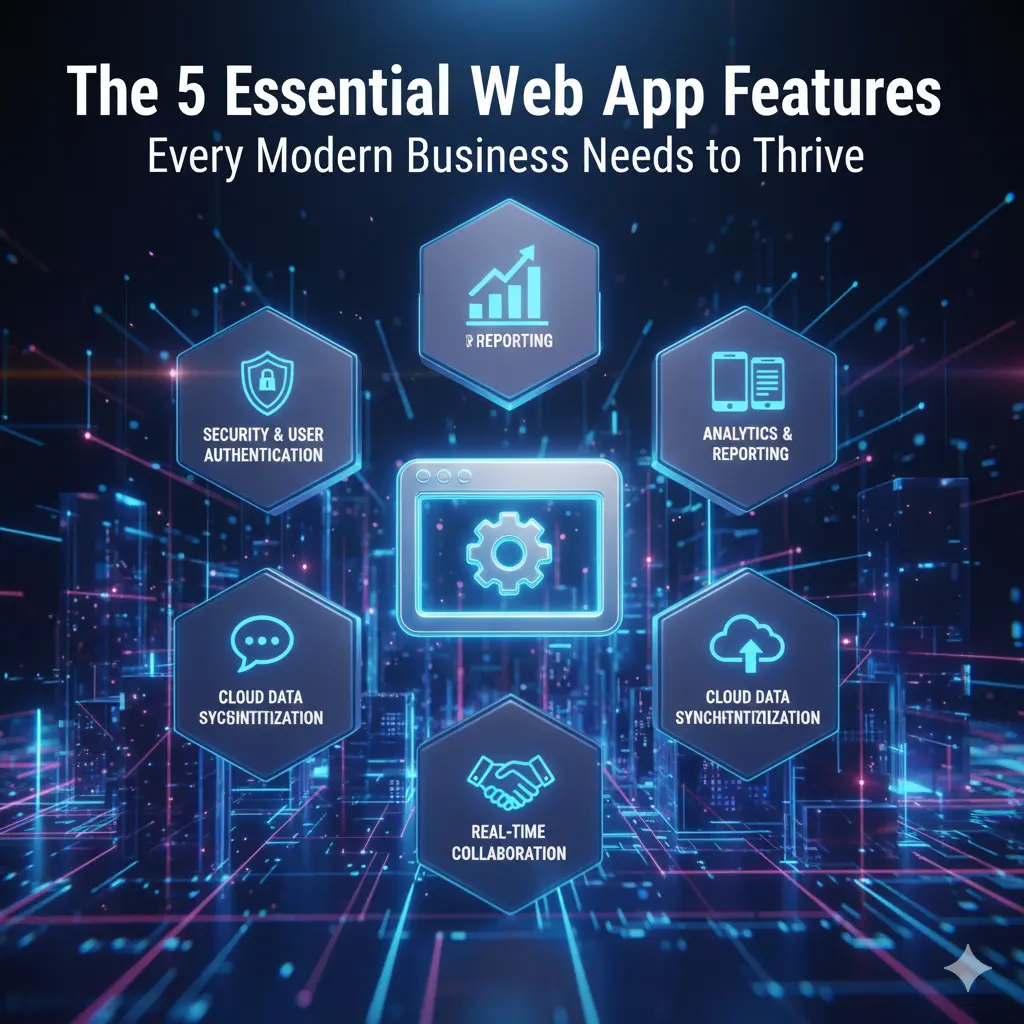Discover the top 5 web app features crucial for your business’s success in 2025. This guide covers everything from responsive design to advanced analytics, helping you excel in web app development.
The 5 Essential Web App Features Every Modern Business Needs to Thrive

In today’s fast-paced digital economy, a strong online presence is non-negotiable for success. A simple website is no longer enough; modern business applications need to be dynamic, powerful, and built to drive growth. A well-designed web application can streamline operations, enhance customer engagement, and provide a competitive edge. But what makes a web app truly great? The answer lies in its core features.
Here are five essential web app features that every modern business needs to thrive.
1. Responsive and Mobile-Friendly Design

In a world where most web traffic comes from smartphones, a mobile-first approach is no longer a trend—it’s a requirement. A responsive design ensures your web app automatically adapts to any screen size, from a large desktop monitor to a tiny smartphone. This is critical for two reasons:
- User Experience: If your app is difficult to navigate on a phone, users will leave. A seamless, intuitive experience on all devices keeps users engaged and improves your brand’s reputation.
- SEO: Google prioritizes mobile-friendly websites and applications in its search rankings. A responsive design is a key signal to search engines that your content is high-quality and accessible.
When planning your web app development, prioritize a clean, uncluttered layout with touch-friendly buttons and a simple navigation menu. This will ensure your app is accessible to your entire audience, regardless of how they access it.
2. Advanced Analytics and Reporting

Data is the lifeblood of any modern business. Without it, you’re flying blind. A truly effective web app must have built-in analytics and reporting tools that provide actionable insights into user behavior.
These features go beyond simple visitor counts. They should help you answer key questions:
- Which features are users interacting with the most?
- Where are users getting stuck or dropping off?
- How effective are your marketing campaigns at driving engagement?
By analyzing user data, you can make informed decisions to improve your app, optimize your marketing, and ultimately increase conversions. This capability transforms your web app from a static tool into a dynamic growth engine.
3. Robust Security and User Management

Trust is the foundation of any business-customer relationship. If your users don’t feel their data is safe, they won’t use your application. Robust security features are non-negotiable, especially for modern business applications that handle sensitive user data.
Your web app should include:
- Secure Authentication: Implement strong password policies and multi-factor authentication (MFA) to protect user accounts.
- Data Encryption: All data, both in transit and at rest, must be encrypted to prevent breaches. Using an HTTPS protocol is the bare minimum.
- User Rights Management: For internal or multi-user apps, this feature allows you to define different access levels. It ensures that employees or clients only see the information they need to, protecting sensitive information and preventing errors.
Investing in security builds user confidence, protects your business from legal and financial risks, and demonstrates your commitment to user privacy.
4. Seamless Third-Party Integrations

In today’s interconnected digital ecosystem, no application exists in a silo. Your web app must be able to “talk” to other services and platforms to create a seamless workflow. This is where API integrations come in.
Third-party integrations allow your app to connect with:
- Payment Gateways: Integrate with services like Stripe or PayPal for secure e-commerce transactions.
- CRMs and Marketing Tools: Sync customer data with platforms like HubSpot or Salesforce to streamline your sales and marketing efforts.
- Communication Platforms: Connect with Slack or Microsoft Teams for internal notifications and collaboration.
By offering these integrations, your web app becomes a central hub that works in harmony with your other business tools, increasing efficiency and providing a smoother experience for both you and your users.
5. Scalability and Performance Optimization

Imagine your web app goes viral, but it crashes under the weight of new users. Scalability is the ability of your application to handle a growing number of users and data without a drop in performance. A successful web app development project is built with scalability in mind from day one.
In addition to scalability, performance optimization is key for user retention. If your app loads slowly, users will get frustrated and leave. Features that optimize performance include:
- Fast Loading Speed: Compressing images, minifying code, and leveraging caching techniques to ensure pages load in seconds, not minutes.
- Efficient Database Management: Optimizing database queries to ensure fast data retrieval, even with large amounts of information.
- Progressive Web App (PWA) Capabilities: For the ultimate user experience, consider a PWA, which offers the speed and offline capabilities of a native mobile app without requiring a download from an app store.
By building a web app that can grow with your business and deliver a consistently fast performance, you’re setting yourself up for long-term success.
